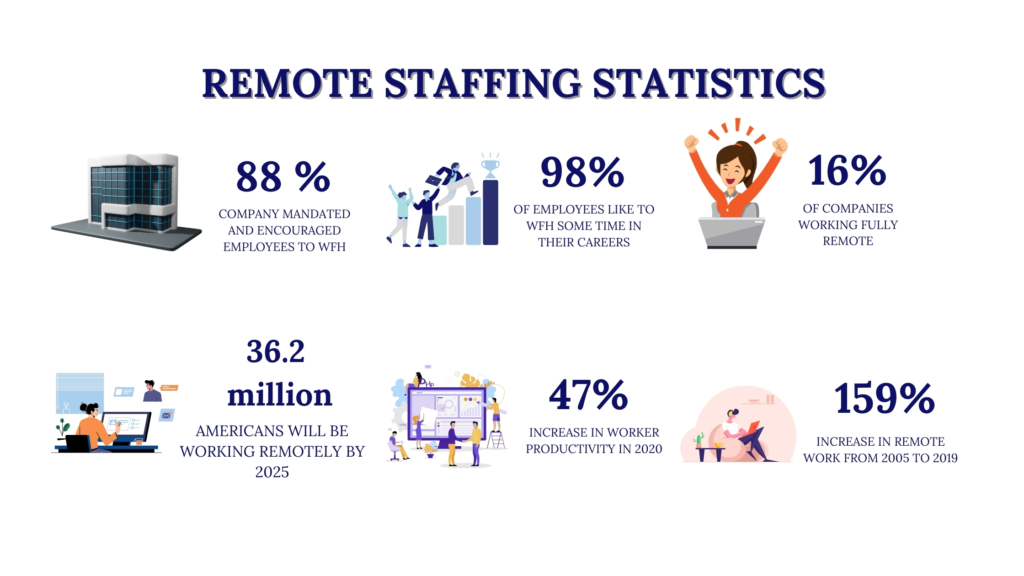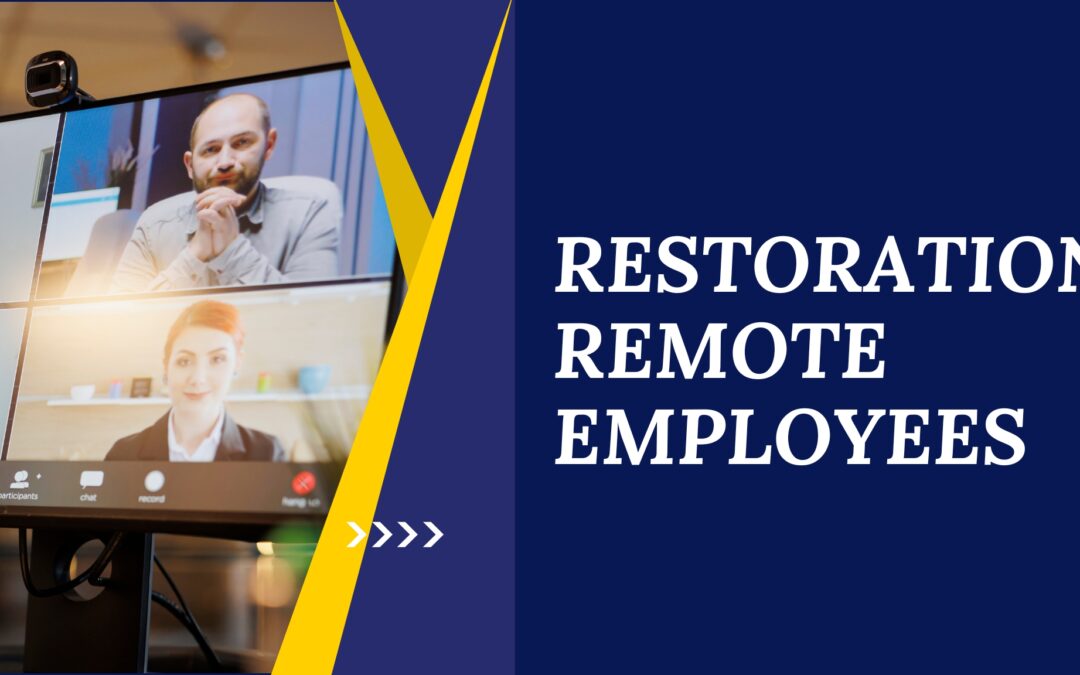Table of Contents
Introduction
The remote revolution is transforming the way we work, and it’s clear that this change is here to stay. The trend of remote staffing is growing rapidly, driven by a combination of technological advancements, shifting employee preferences, and the impact of global events like the COVID-19 pandemic.
As the remote revolution continues to reshape the workforce, mastering remote staffing has become essential for businesses looking to thrive in the modern world. The shift to remote work offers numerous benefits, but it also presents unique challenges that require careful management and strategic planning.
What is Remote Staffing?
Remote staffing refers to the practice of employing workers who perform their job duties from a location outside of the company’s physical office. This can include working from home, co-working spaces, or any location with internet access. Remote staffing encompasses a variety of job roles, from customer service representatives to software developers, allowing employees to operate efficiently without the need to be physically present in an office.
Benefits of Remote Staffing
- Increased Flexibility
- Access to a Global Talent Pool
- Cost Savings
- Enhanced Productivity
- Improved Employee Satisfaction and Retention
- Environmental Benefits
- Business Continuity and Resilience
Key Statistics Showing the Rise of Remote Work

The rise of remote work is more than just a trend—it’s a significant shift in the way businesses operate and employees perform their jobs. Let’s delve into some key statistics that highlight the rapid growth and widespread adoption of remote staffing.
- Explosive Growth in Remote Work
- Remote Work Surge: According to a report by FlexJobs, the number of people working remotely in the U.S. increased by 159% between 2005 and 2019. This growth reflects a broader trend across industries and job roles.
- Pandemic Impact: The transition to remote work was rapidly hastened by the impact of the COVID-19 pandemic. A survey by Gartner revealed that 88% of organizations worldwide mandated or encouraged their employees to work from home during the pandemic.
- Employee Preferences
- Desire for Flexibility: A 2023 survey by Buffer found that 98% of respondents would like to work remotely, at least some of the time, for the rest of their careers. This indicates a strong preference for the flexibility and autonomy that remote work provides.
- Increased Productivity: A study by Prodoscore Research showed a 47% increase in worker productivity in 2020 compared to the previous year. Employees cited fewer distractions and a quieter work environment as key factors contributing to their productivity.
- Business Adoption
- Widespread Adoption: According to Forbes publication, about 16% of companies are already fully remote, operating without a physical office.
- Cost Savings: Businesses are recognizing the financial benefits of remote work. Global Workplace Analytics reports that employers can save an average of $11,000 per half-time telecommuter per year in the USA. These savings come from reduced office space, lower utility bills, and decreased employee turnover.
- Future Projections
- Continued Growth: A study by Upwork predicts that by 2025, 36.2 million Americans will be working remotely, nearly doubling the pre-pandemic rate. This growth trajectory underscores the long-term viability and appeal of remote work.
- Hybrid Work Models: A 2021 survey by McKinsey revealed that 9 out of 10 organizations intend to integrate remote and in-office work, making hybrid work models the new standard. This hybrid approach caters to both employee preferences and business needs.
Key Strategies for Successful Remote Staffing
Remote Communication
Effective communication is essential for the success of remote staffing. Clear and consistent communication ensures that team members stay aligned and connected, regardless of their location. Here are several strategies to enhance remote communication
- Use the Right Tools: Select communication tools that suit your team’s needs, such as Teams for instant messaging and video conferencing, and Monday.com for project management. These tools ensure smooth communication and effective collaboration.
- Establish Guidelines: Define the preferred communication channels, establish expected response times, and set guidelines for virtual meetings. This approach helps set expectations clearly and minimizes the potential for misunderstandings.
- Regular Check-Ins: Schedule regular team meetings, daily stand-ups, and one-on-one sessions to maintain alignment and address any issues promptly.
Ensuring Productivity & Accountability
Maintaining productivity and accountability in a remote setting is similar to an office setup. Here are some tips to ensure your remote team stays productive:
- Set Clear Goals: Establish clear, quantifiable objectives for your team members. Utilize project management tools to monitor progress and ensure everyone remains aligned with the objectives.
- Monitor Performance: Implement tools that help monitor productivity without being intrusive. Regular performance reviews and feedback sessions can help keep team members accountable.
- Encourage Autonomy: Trust your team members to manage their work. Providing autonomy can boost motivation and productivity.
Fostering Collaboration in Remote Teams
Collaboration is crucial for the success of remote teams. Here’s how to foster a collaborative environment:
- Use Collaborative Tools: Utilize tools like Google Docs, Trello, and Microsoft Teams to enable real-time collaboration and document sharing.
- Virtual Team-Building Activities: Plan virtual team-building exercises to foster stronger relationships and boost team morale.
- Encourage Open Communication: Cultivate an environment where communication is open and transparent. Encourage team members to share updates, ask questions, and provide feedback freely.
Enhancing Employee Engagement & Morale
Keeping remote employees engaged and motivated is essential for their productivity and well-being. Here are some strategies:
- Recognize Achievements: Regularly acknowledge and celebrate team members’ achievements. Recognition boosts morale and motivation.
- Provide Support: Ensure that employees have access to the resources and support they need, including mental health support and professional development opportunities.
- Encourage Social Interaction: Promote social interaction through virtual coffee breaks, happy hours, and informal chats. This approach helps create a sense of belonging within the community.
Choosing the Right Technology Tools
Selecting the right technology tools is crucial for effective remote work. Consider the following:
| Instant Messaging | Video Conferencing | Project Management | Collaboration and Document Sharing |
| Slack Microsoft Teams Google Chat Telegram | Zoom Microsoft Teams Google Meet Skype Cisco Webex | Asana Trello Monday.com Basecamp Jira | Google Workspace Microsoft Office 365 Dropbox Notion Quip |
Building Trust & Autonomy
Building trust and providing autonomy are key to successful remote work:
- Trust Building: Foster trust by being transparent, reliable, and supportive. Consistently check in with your team and offer constructive feedback.
- Delegate Authority to Team Members: Encourage team members to independently handle their tasks and make necessary decisions. This boosts their confidence and productivity.
Managing Cultural and Time Zone Differences
Managing a diverse remote team requires sensitivity to cultural and time zone differences:
- Flexible Scheduling: Accommodate different time zones by being flexible with meeting times and deadlines.
- Cultural Awareness: Promote cultural awareness and inclusivity through training and open discussions.
- Effective Communication: Use asynchronous communication methods, when possible, to respect different time zones and ensure everyone stays informed.
Effective Onboarding & Training
Effective onboarding and training are crucial for integrating new remote employees:
- Structured Onboarding: Develop a comprehensive onboarding plan that includes introductions to team members, company culture, and essential tools and processes.
- Continuous Training: Provide ongoing training opportunities to help employees develop their skills and stay updated with industry trends.
- Mentorship Programs: Implement mentorship programs to support new employees and help them acclimate to their roles.
By focusing on these key areas, you can make remote staffing work effectively for your organization, ensuring that your remote teams are productive, engaged, and well-supported.
Karma Staff: Smart Staffing Solutions
Karma Staff is a remote staffing solutions provider offering services such as office administration, estimation, digital marketing, bookkeeping, sales, customer success, and medical billing to property restoration companies and various other industries. Since its inception, the company has continually grown, expanding both its employee base and client roster.
Karma Staff’s success can be attributed to the effective implementation of remote staffing strategies. By utilizing the right communication tools, setting clear goals, fostering collaboration, and ensuring productivity and accountability, Karma Staff has created a seamless and efficient remote work environment. The company also prioritizes employee engagement and morale, building trust and autonomy, celebrating diversity, and providing effective onboarding and training. These strategies have significantly contributed to the success and growth of Karma Staff in the remote staffing industry.
Connect with Karma Staff today to try our remote staffing services.







